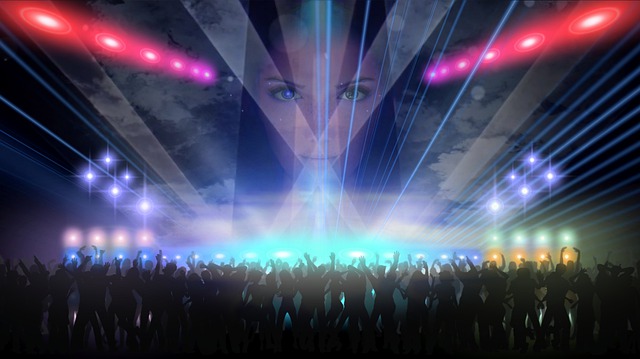
Kyiv’s K41 techno club staff find refuge in Berlin – DW (English)
It was just a regular evening. One colleague was at a birthday party, another had a date. For weeks, Russia had been deploying a threatening military presence on the border with Ukraine, but despite the oppressive mood, life went on. “Until I heard detonations in the morning,” says Katya, who works at the Kyiv K41 techno club. She was about to ask her friends if she had imagined the explosions, when she saw the news on her cell phone.
It was the morning of February 24, the first day of the Russian invasion of Ukraine.
Katya is not the woman’s real name nor are there any photos of her. That was the club’s policy even before the war — no member of the team ever made a public appearance. In addition to the idea of an equal collective, it was part of K41’s image that there would be no photos of parties; cell phone cameras had to be taped to enter the club.
K41 in Kyiv
The internationally known club actually uses the ∄ symbol as its name, an upside-down and crossed-out E, but people simply call it K41, which refers to the address in a former brewery at 41 Kyrylivska Uliza.
The techno club is often compared to Berlin’s famous Berghain club; just a few months ago, a volume of essays — “Notes on 41” — was published in Germany about the club’s creation.
The Kyiv club has hosted world-famous DJs and artists. It expressly aims to be a safe space, especially for people who cannot freely express themselves in society. K41 is a place for queer scene networking. It stands for everything that Vladimir Putin opposes.
When the news of the invasion broke, the team immediately gathered, organized a bulk purchase at the supermarket and stowed away valuable technology.
The club’s management paid next month’s salaries, Katya told DW, adding that any artists booked for that upcoming weekend were already on their way to the border.
Katya remembers a hectic atmosphere as sirens wailed: “Yesterday we lived normal lives, today you hear explosions.” Tickets for buses and trains were already unavailable, she says.
Military controls of passengers
She grabbed her dog, and then she and another woman from the K41 team rushed to the train station, where people were fighting for a place on the train to make their escape, she says, adding one woman even hit her dog. “Under pressure, sometimes there is no humanity anymore,” she says.
All the same, she is grateful for the help they received from other people, first in Ukraine, later abroad. A bus finally took the group to Lviv, where they stayed for two days in a friend’s apartment, before taking another bus across the Polish border to Lublin.
Before leaving Ukraine, the military checked whether men between the ages of 18 and 60 were on the bus: They have been banned from leaving the country, in anticipation that they may be called on to fight.
Crowds jostle on a train platform in Kyiv in early March
Katya arrived in Berlin five days after the war began. In the meantime, about 30 of her friends from the club, which employs about 130 people, have also made it to the German capital.
A friend provided office space in a cultural center and many artists who have performed at K41 helped out with money and housing, she says. “The community shows that it’s not one country’s problem, but a common one,” Katya argues. She calls it a war on humanity.
Boxes are stacked in one corner of the office — an international clothing company, which has a branch in the neighborhood, has donated clothes. A black backpack leaning on a box is the only piece of luggage Katya brought with her.
Building a life, at least for now
They use the office as an impromptu headquarters to organize help for others. “When we were on the run, the information came pouring in unfiltered,” says Katya.
The Ukrainian creative agency Banda helped them set up a bot on the app Telegram, where people seeking help can contact them about work, money or accommodation. More than 16,000 people follow them on Telegram. Even though the messaging service has recently come under fire in Germany for the unregulated spread of conspiracy theories, hate and incitement, it is the go-to app for information and unfiltered communication among Ukrainians and Russians alike.
Donations are collected on the GoFundMe platform, which is also used to support people in Ukraine.
Katya gives a matter-of-fact account of what happened over the past days — until the conversation turns to her family, which stayed behind in Kyiv. She begged them to leave the country, “but they wanted to stay, which is very hard.” You can’t force people to flee, she says, adding she had to respect their decision.
Networks in Berlin
Many people working at the club came from other countries, so the terrible experience of escaping Kyiv may not have been as emotional for them as it was for the K41 Ukrainians, including Katya. “That’s my city, my country, I wanted to stay,” she says. “I lost that.”
Katya is looking for a job and an apartment to share with one of her teammates, so the women won’t have to keep moving. “We are slowly realizing that we need to build a life here,” she says — at least for now, until they can return to Ukraine. They want to settle in, also for the sake of their young dog scampering around the office, looking for attention. Her name is Shalom — peace.
This article was originally written in German.
Source: https://www.dw.com/en/kyivs-k41-techno-club-staff-find-refuge-in-berlin/a-61169254



